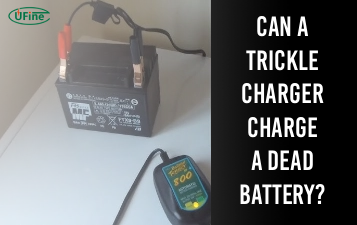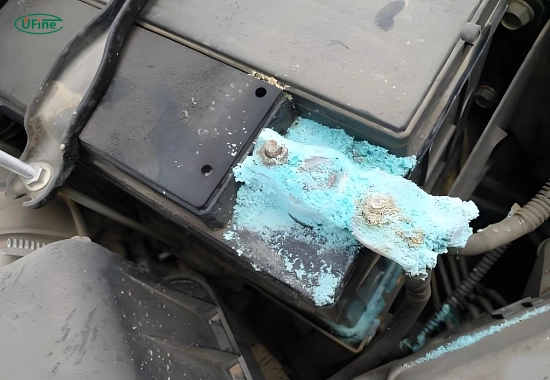
- Part 1. What are battery calcium deposits?
- Part 2. Why do calcium deposits form in lead-acid batteries?
- Part 3. How do battery calcium deposits harm lead-acid cells?
- Part 4. What are the signs of calcium deposits in a battery?
- Part 5. Can calcium deposits be removed from a battery?
- Part 6. How to prevent calcium buildup in lead-acid batteries?
- Part 7. Are calcium-alloy batteries more vulnerable?
- Part 8. How is sulfation different from calcium deposits?
- Part 9. How do I know if my battery charger is causing problems?
- Part 10. What types of batteries are most affected?
- Part 11. FAQs about battery calcium deposits
Battery calcium deposits are among the most dangerous and misunderstood issues affecting lead-acid batteries, especially in vehicles, solar systems, and backup power units. If left untreated, these deposits silently reduce performance, shorten lifespan, and even lead to total battery failure.
Featured Snippet Answer: Battery calcium deposits are hard, crystal-like buildups on the internal plates of lead-acid batteries, especially those made with calcium-alloy. They reduce electrical conductivity, lower a battery’s capacity, and can cause permanent damage if not prevented.
Let’s explore what causes them, how they affect lead-acid cells, and what you can do to prevent or manage them.
Part 1. What are battery calcium deposits?
Battery calcium deposits are crystallized buildups of calcium sulfate and lead sulfate on the positive and negative plates inside a lead-acid battery. These deposits are widespread in batteries that use calcium-alloyed lead plates designed to reduce water loss and self-discharge.
However, these chemical reactions leave behind hard, insulating layers over time due to incomplete charging, high temperatures, and poor maintenance. These layers interfere with ion movement, essential for the battery’s chemical energy conversion.
Consider calcium deposits like cholesterol in arteries — they block flow and reduce performance.
Part 2. Why do calcium deposits form in lead-acid batteries?
There are several reasons calcium and sulfate deposits develop inside a battery:
1. Undercharging
When a battery is not fully charged, sulfate crystals aren’t converted into active material. Over time, these crystals harden and turn into calcium-like deposits.
2. Overcharging
Charging at a too-high voltage can cause water to evaporate, increasing the concentration of sulfuric acid and leading to rapid crystallization on the plates.
3. Infrequent Usage
Batteries left idle for long periods begin to self-discharge, leading to sulfation. Calcium deposits form when the battery is left in this state for weeks or months.
4. High Temperature Environments
Heat accelerates chemical reactions, including those that form insoluble calcium sulfate on the plates.
5. Improper Charger Use
A charger that doesn’t match the battery’s chemistry or lacks smart charging stages (bulk, absorption, float) can lead to high internal resistance and buildup.
6. Battery Age
As batteries age, their internal chemistry becomes less efficient. Deposits are more likely to form in older batteries due to repeated cycling and wear.
Part 3. How do battery calcium deposits harm lead-acid cells?
Calcium deposits are not just cosmetic; they directly interfere with the battery’s ability to operate.
✅ 1. Reduced Electrical Conductivity
The deposits act like an insulating layer, blocking electron flow during discharge and charge cycles.
✅ 2. Decreased Capacity
The plate’s less active surface area means the battery cannot store or deliver as much energy.
✅ 3. Sulfation Hardening
Calcium deposits often accompany or form from sulfation. Once hardened, they become irreversible, especially in sealed batteries.
✅ 4. Increased Internal Resistance
The battery heats up more during charging, wasting energy and increasing damage.
✅ 5. Premature Battery Death
In severe cases, the battery becomes useless, unable to hold a charge or deliver power.
Batteries with heavy calcium buildup may show 0V output even if they seem fully charged from the outside.
Part 4. What are the signs of calcium deposits in a battery?
Identifying calcium deposits early is key. Here are warning signs:
- The battery loses charge quickly
- Long charging times
- Voltage fluctuates abnormally
- The battery won’t charge past 70-80%
- Unusual swelling or gassing
- Visible white-gray crust on terminals or vents
- The battery case feels warm even when idle
These symptoms often mimic other battery issues, but if your battery is less than 3 years old and properly used, calcium deposits could be the hidden cause.
Part 5. Can calcium deposits be removed from a battery?
Yes, but only in some instances — and with limitations.
1. Equalization Charging
This method uses slightly higher voltage to “boil” the electrolyte, helping to soften and remove mild sulfation. It is effective only in flooded batteries.
2. Desulfation with Pulse Chargers
Some smart chargers use high-frequency pulses to break down sulfate and calcium crystals. This slow process works best in the early stages of buildup.
3. Chemical Additives
There are commercial battery additives that claim to dissolve deposits. Results vary, and they often don’t work on complex calcium layers.
4. Manual Reconditioning (Flooded Batteries Only)
It involves draining and flushing the electrolyte, then refilling it with distilled water and acid. Risky, dangerous, and not advised for amateurs.
Warning: None of these methods work on sealed or AGM batteries. Once deposits form there, replacement is often the only option.
Part 6. How to prevent calcium buildup in lead-acid batteries?
Prevention is far easier and more effective than trying to remove deposits later.
✅ 1. Use a Smart Charger
Always use a charger with three-stage or four-stage charging. These prevent overcharging and undercharging.
✅ 2. Charge Regularly
Avoid keeping your battery in a discharged state. Even a sitting car battery should be topped up every 2–3 weeks.
✅ 3. Avoid Heat
Install batteries in cool, ventilated areas. Heat speeds up chemical reactions and deposit formation.
✅ 4. Use the Battery
Frequent cycling helps keep the plates clean. A battery that’s never used will degrade faster than one used moderately.
✅ 5. Monitor Voltage
Use a battery monitor or voltmeter. If the voltage drops below 12.4V for long periods, sulfation and calcium buildup may begin.
Part 7. Are calcium-alloy batteries more vulnerable?
Yes. Lead-calcium alloy batteries are standard in sealed maintenance-free batteries. Still, they are much more prone to irreversible calcium deposits if improperly charged.
While they perform well under ideal conditions, they require:
- Precise voltage regulation
- Regular use
- Protection from over-discharge
If these conditions aren’t met, they can fail quickly due to calcium crystallization.
Part 8. How is sulfation different from calcium deposits?
Sulfation:
- Happens in all lead-acid batteries
- Caused by incomplete charging
- Form soft or hard lead sulfate crystals
- It can be reversible in the early stages
Calcium Deposits:
- Specific to calcium-alloy batteries
- Forms calcium sulfate, which is harder than lead sulfate
- Often not reversible
- Common in sealed or maintenance-free batteries
Sulfation is the gateway. It hardens and may involve calcium, especially in newer battery types, if ignored.
Part 9. How do I know if my battery charger is causing problems?
Your charger could be damaging your battery by:
- Overvolting: Leading to overheating and gas release
- Undervolting: Incomplete charge, causing sulfation
- No float stage: Keeping battery under stress after full charge
- Incompatible profile: Not suited for calcium-alloy or AGM batteries
Always use a charger that matches your battery’s chemistry and specifications. Look for models with temperature compensation, desulfation mode, and soft start.
Part 10. What types of batteries are most affected?
Batteries most vulnerable to calcium deposits include:
- Lead-calcium batteries (Maintenance-free)
- AGM batteries under improper charge
- Flooded batteries are used infrequently
- Standby UPS or solar batteries that aren’t cycled
Even marine or RV batteries can suffer if left idle without proper charging.
Part 11. FAQs about battery calcium deposits
What causes calcium deposits in a lead-acid battery?
Calcium deposits form due to improper charging, long disuse, and high temperatures, especially in batteries with calcium-alloy plates.
Can calcium deposits be removed?
In some cases, yes — with equalization, pulse charging, or chemical additives. But in sealed batteries, deposits are often permanent.
How do I prevent calcium buildup?
Use a smart charger, avoid undercharging or overcharging, and keep the battery in cool, dry conditions. Charge regularly!
Are calcium-alloy batteries better than regular lead-acid?
They offer lower maintenance and longer shelf life, but are less forgiving if not correctly maintained. Use them only if you can meet their charging needs.
Should I replace a battery with calcium deposits?
If the battery shows signs of severe performance loss, won’t hold a charge, or is sealed, it’s best to replace it. Reconditioning may not work.
Related Tags:
More Articles

Can a Trickle Charger Charge a Dead Battery? The Honest Truth
A trickle charger may revive a weak car battery but not one that’s fully drained or damaged. Learn how it works, safe use, and battery care tips.
What Battery to Power Accessories on a Boat: Easy Guide
The best battery for boat accessories is a deep cycle marine battery, built to power lights, fish finders, or stereos safely and reliably.
How Many Cold Cranking Amps Do I Need? The Definitive Guide (2025)
Choosing the right cold cranking amps (CCA) ensures your car starts reliably. Learn how to pick the correct CCA and avoid common mistakes.
Adding Water to a Battery: Safe Guide and Why Lithium Doesn’t Need It
Adding water keeps lead-acid batteries safe and lasting longer. Learn how to do it properly and why lithium batteries never need watering.
Waterproof Battery Box Guide: Protection for Boats, RVs, and Solar Power
A waterproof battery box protects batteries from water, dirt, and damage, extending life and improving safety for boats, RVs, and solar setups.



